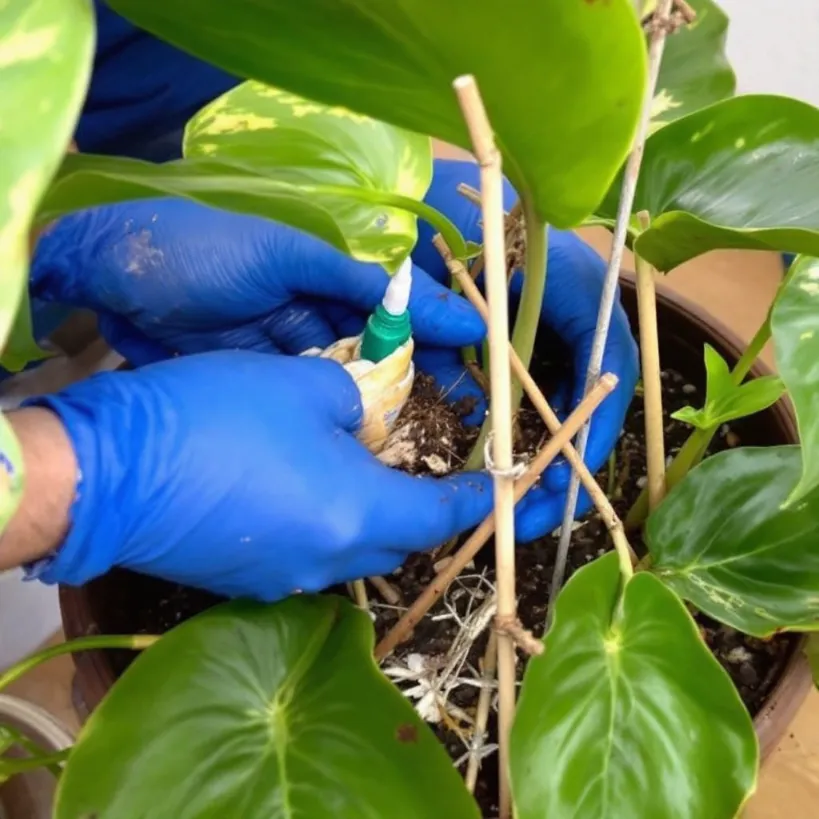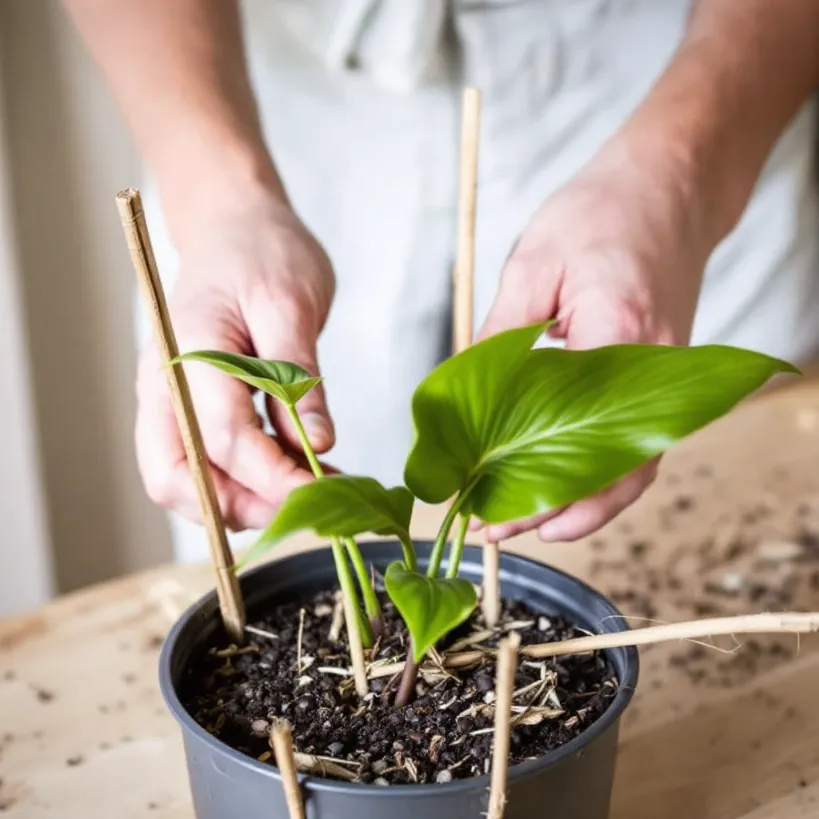Staking a philodendron isn’t rocket science, but it makes all the difference. These plants naturally climb in the wild, using their aerial roots to grab onto trees. In your home, they need that same support. Without a stake, your philodendron sprawls out, gets messy, and never reaches its full potential.
I’ve seen the difference a good stake makes — it’s like watching a slouching teenager finally stand up straight.
The right stake transforms your plant from a floppy mess into an upright showpiece. Your philodendron will grow taller instead of wider, develop bigger leaves, and actually look like the plant it’s meant to be.
Let’s cut through the fluff and get your plant standing tall.
Key Takeaways
- Choose the right support — moss poles work best for climbing philodendrons while simple stakes work for self-heading types
- Stake early when plants are young to train growth patterns effectively
- Mist moss poles regularly to encourage aerial roots to attach
- Secure stems gently with plant ties, never wire or string that can damage the plant
- Position stakes centrally in the pot, ensuring they’re stable and deep enough
- Gradually train stems upward — don’t force them into unnatural positions
Why Stake Your Philodendron?
Not all plants need a crutch, but philodendrons aren’t meant to sprawl across your floor. In their natural habitat, these plants climb up trees using aerial roots. They’re searching for light, not trying to be ground cover.
Without support, many philodendron varieties get leggy and take up too much space. The plant wastes energy on stringy stems instead of making those stunning leaves you actually want. A lemon lime philodendron without support might look okay for a while, but give it a stake and watch what happens — the leaves get bigger, the color gets better.

Staking helps with:
- Growth direction — plants grow up not out
- Space management — keeps your plant compact
- Leaf development — bigger, healthier foliage
- Plant health — better air circulation prevents disease
- Aesthetics — plants look more natural and attractive
Types of Philodendron Stakes
Not all stakes are created equal. Your philodendron doesn’t care about design trends — it wants something that mimics its natural environment.
Moss Poles
The gold standard for most philodendrons. These poles covered in sphagnum moss give aerial roots something to grab onto, just like tree bark in the wild. Your philodendron’s aerial roots will actually grow into the moss, securing the plant naturally.
For vining types like Philodendron micans, a moss pole is your best bet. The moist moss mimics tropical tree bark, encouraging those aerial roots to attach and climb.
Bamboo Stakes
Simple, cheap, and they work. These are better for younger plants or smaller varieties. Bamboo doesn’t provide anything for roots to grab, so you’ll need plant ties to secure the stems.
Coir Poles
Made from coconut fiber, these natural-looking poles provide good grip for aerial roots and hold moisture well. They’re a solid alternative to moss poles.
Trellis Supports
For larger philodendrons, especially spreading types, a small trellis gives multiple climbing paths. These work well for plants that branch out a lot.
How to Choose the Right Stake
The type of philodendron you have matters. Vining varieties like Philodendron hederaceum (heartleaf) need different support than self-heading types like Philodendron gloriosum.
For climbers and creepers, go with:
- Moss poles
- Coir poles
- Climbing trellises
For self-heading types with an upright growth habit, use:
- Simple bamboo stakes
- Metal plant stakes
- Support rings for wider varieties
Size matters too. Your stake should be:
- At least 2-3 feet tall for most indoor philodendrons
- Sturdy enough to support the weight as the plant grows
- Wide enough (for poles) to support the stem thickness
Step-by-Step Staking Guide
Let’s get that philodendron standing tall.
1. When to Stake
The best time is yesterday, the second best time is now. Ideally, stake young plants to train their growth from the start. For established plants that are already sprawling, it’s never too late, but you’ll need more patience to train them.
2. Prepare Your Stake
If using a moss pole:
- Soak the pole in water for 10-15 minutes
- This initial moisture helps aerial roots attach
If using bamboo or other stakes:
- Make sure the stake is clean
- Sand down any rough edges that could damage the plant
3. Position the Stake
- Insert the stake near the center of the pot
- Push it down at least 2-3 inches into the soil
- Make sure it’s stable and doesn’t wobble
- Position it slightly behind the main stems
For larger plants, you might need to stake during repotting to avoid root damage. This is ideal since you can position the stake perfectly without disturbing established roots.
4. Attach Your Philodendron
This is where people get it wrong. Don’t strangle your plant.
- Use soft plant ties, velcro plant tape, or strips of pantyhose
- Create loose loops around the stem and stake
- Leave room for the stem to grow
- Never use wire, twist ties, or anything that can cut into the plant

For moss poles:
- Position the aerial roots against the moss
- Mist the pole regularly to encourage attachment
- Over time, reduce the ties as the plant grabs the pole
5. Train Your Plant
You can’t force a philodendron to climb overnight. This is a gradual process.
- Guide new growth toward the stake
- Add ties as the plant grows taller
- For stubborn plants, check that your stake material is suitable
- Mist moss poles 2-3 times a week to encourage attachment
Maintenance Tips
A one-and-done approach doesn’t work with climbing plants. They need ongoing attention.
Moss Pole Moisture
The biggest mistake with moss poles? Letting them dry out. Dry moss doesn’t attract aerial roots.
- Mist the pole regularly, focusing on where aerial roots contact the moss
- In low humidity environments, mist more frequently
- Some gardeners use a small reservoir system for constant moisture
Climbing philodendrons like the Philodendron verrucosum particularly benefit from consistent moss pole moisture, as they produce abundant aerial roots.
Adjusting Ties
As your plant grows, those ties need attention:
- Check monthly for any ties becoming too tight
- Loosen or replace ties that constrain growth
- Add new ties to support new growth
- Remove ties where the plant has attached naturally to the moss
Pruning and Maintenance
Sometimes you need to trim to encourage better climbing:
- Remove lower leaves that yellow or die back
- Prune leggy growth to encourage bushier development
- For very long vines that won’t climb, consider propagating them instead
Learning the proper pruning techniques for philodendron plants helps maintain an attractive shape while encouraging upward growth.
Different Staking Methods for Various Philodendron Types
Not all philodendrons climb the same way, and their staking needs differ.
Vining Philodendrons
For trailing types like heartleaf philodendron:
- Need continuous support as they grow
- Benefit most from moss poles
- Will climb almost indefinitely with proper support
Self-Heading Philodendrons
For varieties like Philodendron Imperial Red:
- Need support mainly for stability
- Simple stakes work well
- May only need staking when young or if growth becomes top-heavy
Large-Leaf Varieties
For statement plants with massive leaves like Philodendron Splendid:
- Need very sturdy support
- May benefit from multiple stakes
- Often need support to prevent leaf weight from toppling the plant
Troubleshooting Common Staking Issues
Even with the best intentions, problems happen.
Plant Won’t Climb
If your philodendron refuses to climb:
- Check if your pole material is appropriate
- Ensure the moss pole stays consistently moist
- Verify you have a climbing variety (not all philodendrons climb)
- Position aerial roots directly against the climbing surface
Leaning or Unstable Stakes
When your support system fails:
- Use a wider, heavier pot to prevent tipping
- Insert the stake deeper into the soil
- For tall plants, consider multiple stakes
- During repotting, position the stake close to the center
Damaged Stems
If you see stem damage:
- Immediately loosen any tight ties
- Replace hard ties with soft, flexible materials
- Give damaged areas time to heal before reattaching
- Consider a wider pole that requires fewer ties
DIY Stake Options
Don’t want to buy commercial stakes? Make your own:
DIY Moss Pole
- Get a PVC pipe or wooden dowel
- Wrap with chicken wire, leaving a cylinder shape
- Pack with moist sphagnum moss
- Secure moss with fishing line or plant wire
Repurposed Supports
Items you can repurpose:
- Old bamboo blinds cut to size
- Fallen tree branches (baked in oven to kill pests)
- Garden trellises cut to fit indoor pots
When to Upgrade Your Stake
Plants outgrow their support. Signs you need a taller or sturdier stake:
- Plant has reached the top of the current stake
- Support leans or seems unstable
- Stakes or ties break under the plant’s weight
- Newer leaves are smaller due to inadequate support
When upgrading, do it gradually. Complete replacement can shock the plant.
Best Philodendron Varieties for Staking
Some philodendrons are staking superstars that transform dramatically with support:
- Philodendron Micans — Velvety leaves show off better when climbing
- Philodendron Brasil — Variegation becomes more pronounced with proper light exposure when staked
- Philodendron Birkin — Though more upright naturally, staking helps maintain its compact form
- Philodendron Melanochrysum — Needs support to show off its massive velvety leaves
- Philodendron Squamiferum — The unusual red stems and lobed leaves display better when climbing
Aesthetic Considerations
Beyond function, stakes affect how your plant looks.
Decorative Options
Make the stake part of your decor:
- Paint lower portions of bamboo stakes
- Use decorative trellises that complement your home style
- Consider copper or brass plant supports for modern aesthetics
Positioning for Display
How you stake affects the plant’s silhouette:
- Central stake for a symmetrical look
- Offset stake for a cascading effect on one side
- Multiple stakes for a fuller, bushier appearance
References:
- https://coinmarketcap.com/academy/article/crypto-staking-guide
- https://foliagefriend.com/how-to-stake-philodendron/
- https://wiki.polkadot.network/docs/learn-staking
- https://coinmarketcap.com/academy/article/the-ultimate-guide-to-ethereum-liquid-staking
- https://phantom.app/learn/crypto-101/solana-liquid-staking
- https://www.youtube.com/watch?v=fP-W2NGmFKw
- https://www.livelyroot.com/blogs/plant-care/how-to-propagate-philodendron
- https://www.thespruce.com/philodendron-gloriosum-growing-guide-5272126
You Might Also Like
- This approach is complemented by the strategies outlined in our Philodendron Propagation: 5 Expert Methods for Success resource Philodendron Propagation: 5 Expert Methods for Success.
- This approach is complemented by the strategies outlined in our Philodendron Gloriosum Care: Expert Tips for Thriving Plants resource Philodendron Gloriosum Care: Expert Tips for Thriving Plants.
- To understand this better, consider reading about Philodendron Light Needs: Expert Guide for Thriving Plants Philodendron Light Needs: Expert Guide for Thriving Plants.